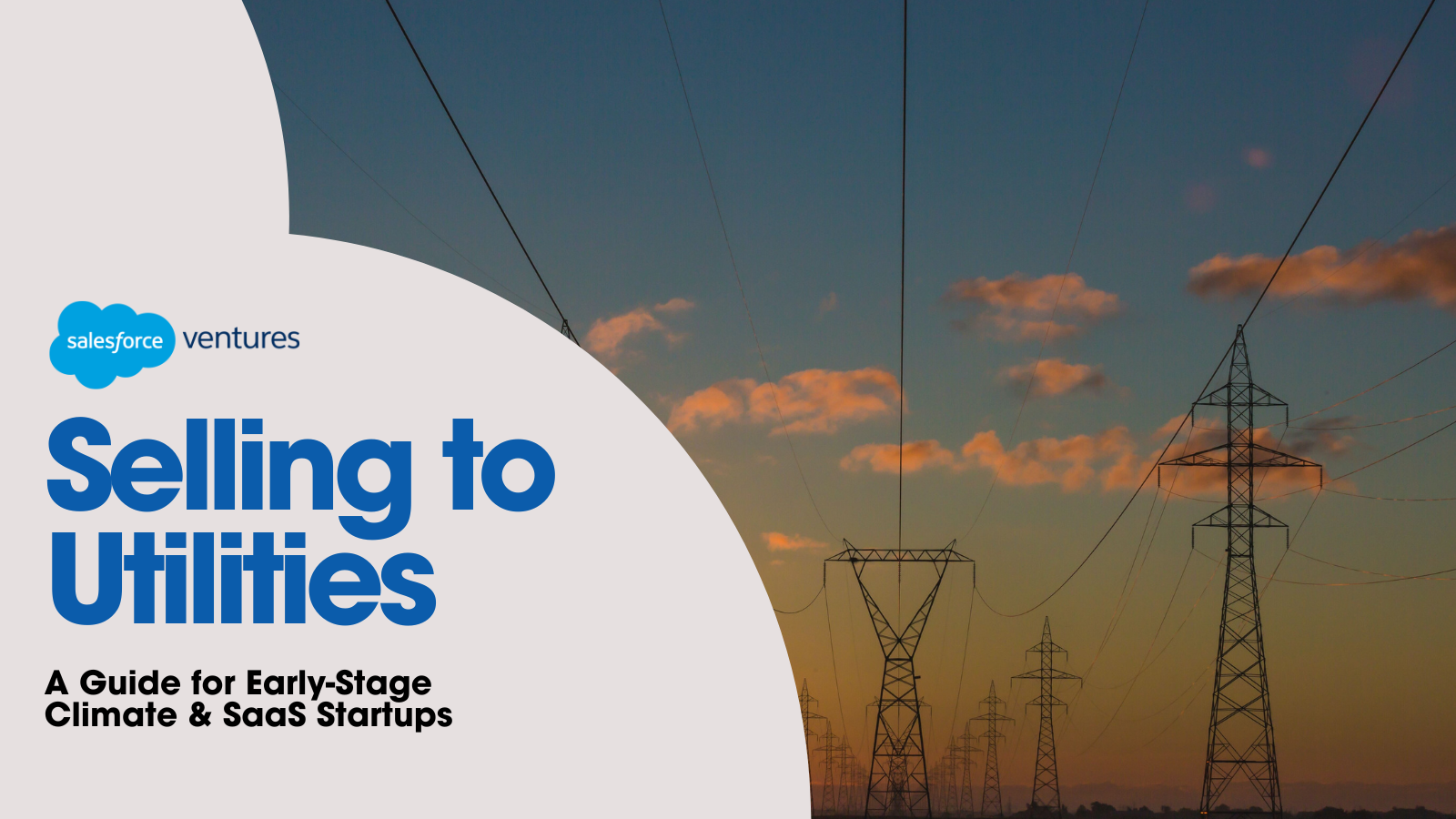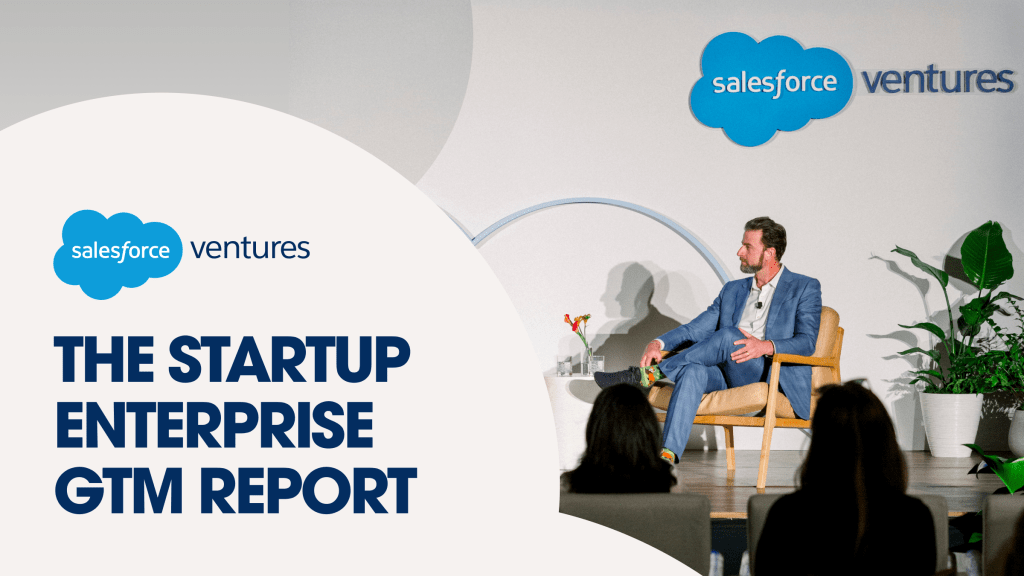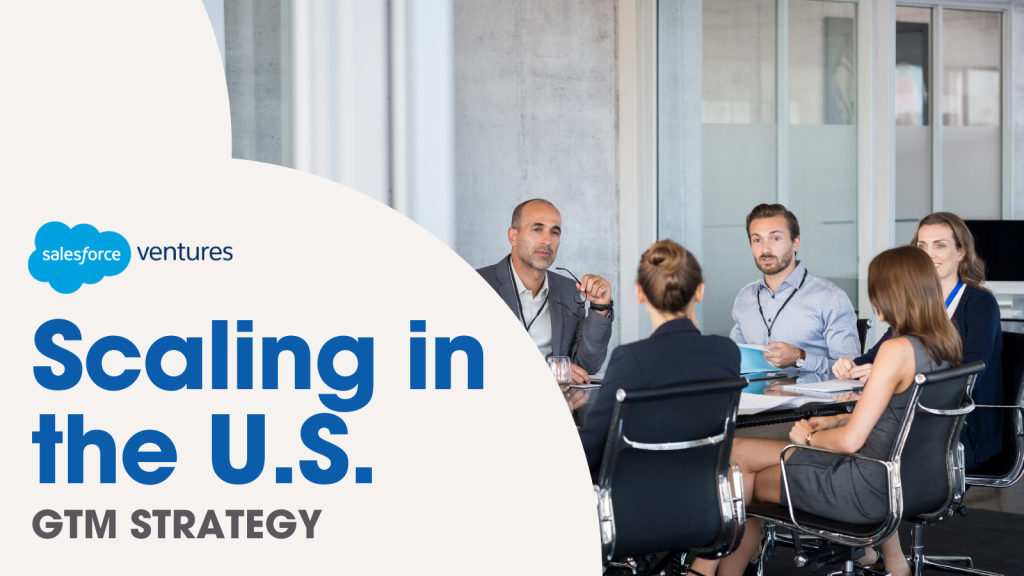
Selling to Utilities: A Guide for Early-Stage Climate & SaaS Startups
Everything startups need to know to nail their utility go-to-market motion.
Utilities sit at the center of the clean energy transition. These enterprises own the energy grid infrastructure that powers our homes and businesses. Importantly, they must meet sustainability targets while ensuring reliable and affordable electricity supply to customers.
At Salesforce Ventures Impact Fund, we’ve been investing in climate tech for the past seven years. We understand how critical utility innovation is to a cleaner future. At the same time, we recognize the difficulties startups face selling these pioneering technologies to utility companies.
For many early-stage startups, earning a contract with a utility provider is a major breakthrough that can set a business on a path to success. However, the process of selling to utilities can be beset by long sales-cycles, numerous decision-makers, varying regulations, and a culture that can be risk averse to emerging technologies.
For these reasons, Salesforce Ventures recently hosted a workshop to support portfolio companies selling to regulated utilities. The session featured Larry Goldstein, Senior Director of Product Strategy for Salesforce’s Energy & Utilities Cloud, and Leo Trudel, Director of Innovation and Technology at Indigo Advisory Group, a digital strategy consulting firm for electric utilities.
Larry and Leo shared practical advice for startups hoping to break into the utilities market. In this guide, we present an overview of their framework, supplemented with our own insights and best practices for a utility go-to-market (GTM) motion.
Understand your ideal customer profile (ICP)
The ideal customer profile defines the qualities of the stakeholders being targeted by a sales pitch. Utilities are large enterprises with multiple stakeholders involved in purchasing decisions. Selling into utilities requires a strategic selling approach that includes mapping these stakeholders, their key drivers, and their influence on the decision making process. While every utility company is different, there are generally five groups of stakeholders that startups should focus on during the sales process, each with their own set of priorities:
- C-suite: Utility company executives are primarily concerned with achieving their key performance indicators (KPIs). These KPIs may pertain to customer satisfaction, net zero goals, safety, reliability, or operational efficiency. Startups should aim to present the C-suite with proof points of other utility companies that hit their KPIs using the startup’s solution.
- Business users: Business users will look to integrate a new product or service if they believe it will help them achieve success on a project or program. The business user’s need can help push an IT organization that otherwise may not be interested in integrating an emerging technology from an early-stage company.
- IT: IT will evaluate new software based on a number of criteria. IT will likely first consider whether an existing software can address the problem or if they can build the solution internally. IT will then consider ease of integration with the utility’s existing workflows and systems. Next, IT will conduct a security review process, with specific criteria for cloud-hosted software. It’s important to remember that large utilities typically have hundreds of applications, so they will be comparing new solutions to existing platforms. Also note that IT stakeholders are heavily influenced by their third-party systems integrators (SIs). SIs have their own set of priorities, which sometimes differ from those of the utility and third party vendors. When selling to IT, the business user will be the startup’s best ally throughout the sale, as IT ultimately serves the interests of the business user. Pushback from IT typically occurs when the team feels they can build the solution internally, the software poses security or skill set concerns (i.e., IT doesn’t understand the software enough to support it or has an SI that understands it), or there are budget or timing constraints.
- Procurement: The procurement department oversees all software acquisitions. Given the lengthy cycles associated with utility sales, these stakeholders are most concerned with vendor viability (i.e., how well-capitalized the vendor is and who its customers are).
- Regulatory affairs: Regulatory affairs is focused on meeting the utility’s regulatory requirements and regulatory stakeholder management. The regulatory team is also the lead in utility filings and proceedings related to utility funding—including the utility general rate case. The rate case is the primary regulatory funding proceeding for any investor-owned utility, as well as program-specific filings such those for energy efficiency and electric vehicle programs (more on rate cases further down). Engaging the regulatory team can help startups understand if and how software and implementation costs can be covered by various funding sources. For example, startups can explore whether the cost of the software license can be capitalized (CapEx) or treated as an operational expense (OpEx). Regulatory has an agenda and goals with each of their regulatory filings. If a startup’s software solution helps in supporting that regulatory agenda, it can earn a strong advocate within the utility.
Given every utility company operates somewhat differently, a best practice is to rewrite the ICPs for each individual utility provider being sold into.
“Be rigorous in mapping your stakeholders—the people who make decisions, influence decisions, or who can shut you down,” Goldstein said. “Understand who they are, what their title is, what their concerns are, and what their motivations are.”
While utility sales cycles can be lengthy, generating interest and excitement from internal customer groups can be accomplished using ordinary sales motions. If startups present a solution that solves a business problem the utility can’t accomplish on its own, requires little training, has good data transparency, and a positive market reputation, they’ll be able to generate interest.
Learn the culture of utilities
Utilities companies must deliver safe and reliable service to customers. As such, these organizations move cautiously and are often slow to change as a means of managing risk. Commonly, utilities are also siloed, with communication between departments restricted as a result of longstanding cultural norms and mandatory security protocols. Further, utility companies are not particularly tech-forward relative to their industry counterparts, meaning they’re not overly familiar with SaaS solutions or how they can support the business.
Given this culture, startups selling to utilities must wear three different hats:
- Evangelist: Startups must promote their product and find or develop internal champions to promote it to colleagues (e.g., business users, regulatory affairs). Because utility companies are siloed, startups must take the initiative to move horizontally through the organization to ensure all potential stakeholders are aware of their solution and see value in it. Note that utilities prioritize reliability in virtually all purchases they make. They often associate reliability with brands that have solid, long-standing reputations. For this reason, utility companies may avoid doing business with startups. As such, it can be advantageous for startups to emphasize any high-profile partnerships (including well-known investors, affiliates, systems integrators) to foster credibility with stakeholders. Given regulated utilities do not directly compete, they tend to communicate and share information with each other and often look to other utilities as references on a proposed solution.
- Educator: Startups must explain how to think about the solution and how stakeholders should evaluate it. Operators at utility companies have typically been in their role for many years and may not know how best to gauge the value of a SaaS tool. So if, for example, the product in question uses computer vision to assess asset health, explain to Procurement that the best way to evaluate their options is to administer tests that are graded on processing time and accuracy.
- Sales Engineer / Systems Architect: A startup should be able to propose architecture for how its solutions can fit into the utility’s existing environment both from a systems replacement and integration perspective. Because utilities are risk-averse, startups should expect roadblocks and come to the table with ideas on how to navigate them.
It’s important for startups to learn the “idiosyncrasies” of the utility in order to engage in the most effective fashion.
“Each utility is different, and you’re not going to figure out how these organizations buy software unless you do your research and talk to a bunch of internal stakeholders,” Trudel said. “And then once you understand those dynamics, it’s up to you to execute a strategy that gets everybody on board and the deal moving forward.”
Understand where the money comes from
Utilities receive the majority of their funding through regulatory filings and proceedings. The largest of these, as previously mentioned, is the general rate case.
Rate casing is the process by which a utility company sets the rate it charges customers for services to match the costs incurred to provide those services. The rate case process involves preparing and filing a rate case with the regulatory body that governs the utility, evidence gathering, and several rounds of public hearings (this video provides a good overview of the rate case process).
Having a rate case approved essentially enables the utility to pass on increases in costs (say, from a new SaaS tool) to customers. Supporting a utility provider with their rate case can help a startup secure the sale. Because the rate case process is different for every utility (utilities report into different federal and state regulators), startups should look into whether their target customers have rate-cased SaaS products in the past. If they have, seek to understand how the utility successfully rate cased the software, as this can provide insight into how future SaaS expenses can be passed along to customers. Note that rate case eligibility typically applies to CapEx and not ongoing expenses, such as recurring SaaS fees.
“One thing that can be really helpful is looking at old rate cases that have included SaaS software, and then asking the regulatory affairs folks how they handled that process,” Trudel said. “You can then play the role of sales engineer and figure out what you can do to get your software included in the rate case based on the rules the utility company must abide by.”
There are 50 different state regulators as well as numerous federal regulators governing more than 5,000 utilities providers in the U.S. Each of these regulators has a different level of regulatory oversight and compliance related requirements. What’s more, within each utility there are numerous individuals who have varying knowledge of regulatory processes and compliance procedures.
This mosaic of compliance rules and stakeholder interpretations means there’s no single solution for winning rate case approval that applies to all customers. SaaS companies should engage with stakeholders to gain knowledge of each client’s interpretation of their unique regulatory frameworks, share best practices and anecdotes of other utilities that won rate case approval for SaaS products, and see if there’s a path forward for securing funding via rate increases, rather than from utilities’ profit margins.
Because rate-casing is a complex and time-intensive process, startups should also consider other sources of capital that may be used to compensate vendors. Again, this requires understanding the idiosyncrasies of the utility provider. There are regulatory programs for energy efficiency, electric vehicles, and income qualified programs that provide funding specific to meeting those regulatory program goals.
Understanding what funding source(s) are relevant and can be applied to software license and implementation costs is critical to getting a SaaS purchase project funded—as is understanding how those software and implementation costs are allowed to be treated (i.e., CapEx vs. OpEx).
Utility sales in summary
Utility sales is a complex enterprise selling cycle that can feel daunting to a startup. But startups that take the time and effort to understand the organization, stakeholder dynamics, and funding mechanisms described above can find success. The value of these contracts—both financial and reputational—often makes utility sales a worthwhile investment.
Climate tech startups have incredible solutions from which utilities could benefit. We hope the sales strategies we’ve detailed in this guide can facilitate increased adoption of these solutions in the coming years.
—
Salesforce Ventures Impact Fund hosts frequent workshops with Salesforce experts designed to address our portfolio companies’ recurring challenges and chart a path to success. The Impact Fund is currently investing in enterprise software startups that drive measurable social and environmental impact. To learn more about the Salesforce Ventures Impact Fund, visit our website.
Disclaimer
The information provided in this article does not, and is not intended to, constitute legal or financial advice; instead, all information, content, and materials available are for general informational purposes only. Readers should contact their attorney or financial representative to obtain advice with respect to any particular legal or financial matter. Opinions of the referenced presenters and/or author are their own and do not necessarily reflect the official position of Salesforce.





